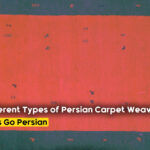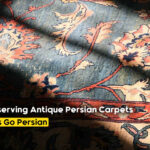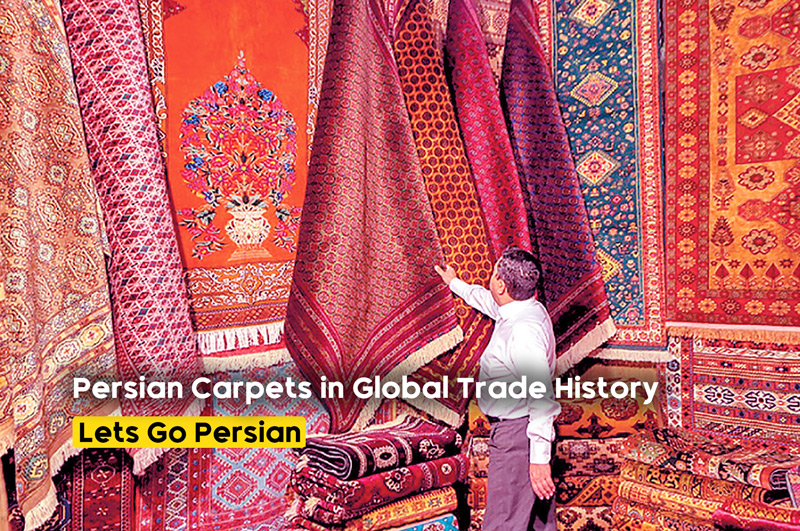
A Guide to Different Types of Persian Carpet Weaves

Preserving Antique Persian Carpets
For centuries, Persian carpets have been one of the most sought-after commodities in the world. Renowned for their exquisite craftsmanship, intricate designs, and cultural significance, Persian carpets have played a pivotal role in global trade history. They were not only valuable goods exchanged along the famous Silk Road but also symbols of status and luxury in royal courts and wealthy households across Europe, the Middle East, and Asia. This blog post explores the critical role Persian carpets have played in the development of international trade, from ancient times to the modern era, and how they have shaped global cultural exchanges.

The Role of Persian Carpets in Global Trade History
1. Early History of Persian Carpets in Trade
Ancient Beginnings: The Birth of Persian Carpets
The art of carpet weaving in Persia, modern-day Iran, dates back more than 2,500 years, with some of the earliest evidence found in ancient tombs and archaeological sites. One of the most famous early examples of Persian carpet-making is the Pazyryk Carpet, discovered in Siberia, which dates to around the 5th century BCE and shows remarkable Persian craftsmanship.
- Trade in the Ancient World: Persian carpets were already a valuable commodity during the Achaemenid Empire (550–330 BCE), which established Persia as a central hub in global trade networks. Carpets were exchanged as luxury goods with neighboring civilizations, including Babylonia, Egypt, and Greece.
The Role of the Silk Road
The rise of the Silk Road during the Parthian and Sassanian Dynasties (247 BCE – 651 CE) solidified Persia’s position as a key trading power. This extensive network of trade routes connected East Asia, the Middle East, and Europe, facilitating the exchange of goods, culture, and ideas.
- Persian Carpets as a Trade Commodity: Persian carpets became one of the most prized exports on the Silk Road. Their beauty and durability made them highly desirable in distant lands, including China, India, and the Roman Empire. Persian weavers began to adapt their designs to suit the tastes of foreign markets, producing carpets with a wide range of patterns and motifs.
2. The Safavid Dynasty: The Golden Age of Persian Carpets and International Trade
Safavid Patronage and Expansion
The Safavid Dynasty (1501–1736) is often referred to as the Golden Age of Persian carpet weaving. Under the reign of Shah Abbas I (1588–1629), the Persian carpet industry flourished, reaching new heights of artistic excellence and becoming a cornerstone of international trade.
- Royal Workshops: Shah Abbas I established royal workshops in Isfahan, Tabriz, and Kashan, bringing together the most skilled weavers and designers to produce carpets of unparalleled quality. These carpets were often woven from silk and featured intricate floral and medallion designs.
- Influence of European Markets: The Safavid rulers recognized the importance of international trade and worked to strengthen ties with European powers. Persian carpets were exported to Italy, France, Spain, and England, where they became symbols of wealth and sophistication.
Persian Carpets in European Art and Culture
During the Safavid era, Persian carpets became highly sought-after luxury items in Europe. They frequently appeared in the paintings of Renaissance artists, symbolizing wealth and prestige. For example, Hans Holbein and Lorenzo Lotto included detailed depictions of Persian carpets in their works, further fueling European fascination with these exotic textiles.
- Diplomatic Gifts: Persian carpets were often presented as diplomatic gifts to European royalty and dignitaries. The carpets were highly valued for their craftsmanship and beauty, and they played a role in enhancing Persia’s reputation as a cultured and wealthy empire.
- Trading Companies: European trading companies, such as the Dutch East India Company and the British East India Company, began to establish strong commercial ties with Persia, further integrating Persian carpets into the global trade network.
3. Persian Carpets in the 19th Century: European Demand and Industrialization
The Influence of European Markets in the 19th Century
By the 19th century, Persian carpets had become deeply integrated into global trade networks, particularly with Europe. The demand for Persian carpets in European markets grew steadily, leading to increased production and changes in design to suit Western tastes.
- European Influence on Design: As European demand for Persian carpets increased, some workshops began incorporating European-inspired patterns into their designs. These carpets often featured softer colors and more symmetrical patterns to appeal to European buyers.
- The Great Exhibitions: Persian carpets were frequently showcased at the World’s Fairs and Expositions, such as the Great Exhibition of 1851 in London and the Exposition Universelle in Paris in 1867. These events introduced Persian carpets to a wider audience and cemented their status as a symbol of luxury.
The Industrial Revolution and Persian Carpet Production
The Industrial Revolution in Europe had a significant impact on Persian carpet production. As mechanized textile production grew in Europe, there was concern that traditional hand-woven carpets might be replaced by machine-made imitations. However, the superior quality and artistic value of authentic Persian carpets ensured their continued dominance in the luxury market.
- Machine-Made Imitations: By the late 19th century, European and American manufacturers began producing machine-made carpets that imitated Persian designs. While these carpets were cheaper and more readily available, they lacked the craftsmanship and cultural authenticity of hand-woven Persian carpets.
- Persian Response: To maintain the prestige of their carpets in global markets, Persian weavers doubled down on quality, producing increasingly complex and finely woven designs. Silk and natural dyes continued to be used to ensure the superiority of Persian carpets over their machine-made counterparts.
4. Persian Carpets in Modern Global Trade
Revival and Modernization in the 20th Century
In the early 20th century, the Persian carpet industry faced challenges due to changing market preferences, political upheaval, and the rise of modern manufacturing. However, the demand for high-quality, hand-woven carpets persisted, particularly among art collectors, interior designers, and cultural enthusiasts.
- Cultural Preservation and Global Appeal: By the mid-20th century, Persian carpets had become sought-after collector’s items, with vintage and antique carpets fetching high prices at international auctions. Governments and cultural institutions in Iran worked to preserve the heritage of carpet weaving through training programs and artisan workshops.
- Innovation in Design: Persian carpet weavers began experimenting with more modern designs, incorporating abstract patterns, new color schemes, and contemporary influences, while still maintaining traditional weaving techniques. This innovation helped Persian carpets stay relevant in the international design market.
Persian Carpets in the Contemporary Global Market
Today, Persian carpets remain a highly prized commodity in global trade, with their reputation for quality, artistry, and luxury firmly intact. While mass-produced carpets dominate the lower end of the market, hand-woven Persian carpets continue to be regarded as investment pieces, appreciated for their cultural value and fine craftsmanship.
- High-End Markets: Persian carpets are regularly featured at prestigious auction houses such as Sotheby’s and Christie’s, where rare antique carpets can sell for millions of dollars. For example, the Clark Sickle-Leaf Carpet, a 17th-century Persian rug, sold for a record-breaking $33.7 million in 2013.
- Cultural Exports: Persian carpets continue to play an important role in Iran’s cultural exports. Despite political sanctions and trade restrictions, they are exported to major markets in Europe, North America, and Asia, where they are cherished for their craftsmanship and cultural significance.
5. The Cultural Impact of Persian Carpets on Global Trade
A Bridge Between East and West
Persian carpets have not only been valuable trade goods but also cultural ambassadors, facilitating the exchange of ideas and artistic influences between East and West. Through centuries of trade, Persian carpet designs have influenced textile arts in regions as diverse as India, Turkey, and Europe.
- Influence on European Design: The intricate floral and geometric patterns of Persian carpets have influenced European textile design for centuries. Persian carpets introduced Europeans to new styles of symmetry, color palettes, and design motifs, which were later incorporated into European fabrics, tapestries, and carpets.
- Cultural Exchanges Along the Silk Road: As Persian carpets moved along the Silk Road, they carried with them elements of Persian culture, art, and spirituality. In turn, Persian weavers were influenced by the artistic traditions of other cultures, creating carpets that reflected a blend of Eastern and Western motifs.
Persian Carpets as Symbols of Status and Luxury
Throughout history, Persian carpets have been more than just floor coverings—they have been symbols of wealth, status, and cultural refinement. From royal courts to modern-day collectors, owning a Persian carpet is seen as a mark of sophistication and prestige.
- Persian Carpets in Art and Literature: Persian carpets are often depicted in Western art and literature as symbols of luxury and exoticism. From the palaces of European monarchs to the homes of contemporary collectors, Persian carpets have maintained their reputation as highly prized status symbols.
Conclusion
Persian carpets have played an essential role in global trade history, serving as valuable commodities that connected East and West along the Silk Road and beyond. Over the centuries, they have not only enriched the cultural exchanges between nations but also stood as a testament to the artistry and craftsmanship of Persian weavers. Today, Persian carpets remain iconic symbols of luxury and cultural heritage, continuing to captivate collectors, designers, and art enthusiasts across the world. Their enduring presence in global trade is a reflection of their timeless beauty, unparalleled craftsmanship, and deep cultural significance.



















